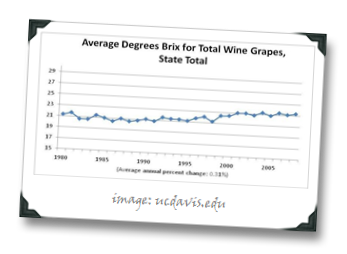Want Some Wine with that Booze...?
May 24, 2011
The Center for Wine Economics released a report of a recent study on the sugar levels of wine grapes in California, titled “Too Much of a Good Thing? Causes and Consequences of Increases in Sugar Content of California Wine Grapes.” Not sure how new this news is, but it was new to me so I’m yappin’ about it!
While that title of the report doesn’t sound particularly fascinating, the report’s conclusions are – if you’re a wine geek, that is, and if you’re a fan of California fine wine and have ever wondered why alcohol levels seem to be kind of high in the premium vino coming out of that state. According to the report, it’s not just your imagination – wine grapes in CA have indeed been getting riper over the last twenty years, which translates into higher booze levels, with white grapes bearing the brunt of the increase:
“The data show that the average alcohol percentage increased by 0.30 percent, with a larger increase for white wine (0.38 percent) than for red wine (0.25 percent). This increase in alcohol percentage is consistent with an increase in the sugar content of the grapes used to make that wine of 0.55 degrees Brix, on average.”
That sugar measurement might look small, but according to the report it’s a “substantial” increase, and it’s that rise in sugar levels that is making CA wines a bit more… busty than they’ve been in the past (I imagine if you were used to drinking CA wine from 20 years ago, drank too much, passed out and pulled a Rip Van Winkle, upon waking up in 2011 you’d be forgiven for thinking that during your extended slumber your fave CA Cab had undergone the vinous equivalent of a boob job). What this study does that is so fascinating is this: it puts data and critical thinking behindsomething that many CA wine drinkers may have already suspected… CA fine wines are getting boozier, and it might be the result of the fine wine market…
Now, we’ve all heard of global warming, right (if not, please remove the large boulder from over your head and read the news)? Well, it must be getting warmer in CA winegrowing regions, raising the sugar in the grapes due to the higher temperatures, and thus increasing the alcohol content in the final wine, right?
Not necessarily. According to the CWE study, the weather patterns have had a minimal impact on grape sugars during the last twenty years:
“…an increase in heat during the growing season would contribute to an increase in the sugar content of grapes. However, the heat index did not exhibit any statistically significant growth during the growing season..”
So what is causing the increased sugar = increased booze? Probably the CA wine biz reaction to consumer demand. According to the study, it seems that premium wine varieties (especially reds) have seen some of the most dramatic sugar level increases – and they propose that this could be due to critics like Robert Parker giving higher scores to riper, more concentrated wines. This in turn causes consumers to demand those wines with higher scores, which causes winemakers to try to get higher scores, which causes grape growers to leave grapes hanging on the vines longer in an attempt to achieve more ripeness (and therefore raising the sugar levels in the grapes). To the study:
“In all of the models… the analysis shows a higher propensity for growth in sugar content for premium varieties, compared with non-premium varieties, even though premium varieties had higher sugar content to begin with. This feature and the patterns of the level of sugar content among regions and varieties could be consistent with a “Parker effect” where higher sugar content is an unintended consequence of wineries responding to market demand and seeking riper flavoured more intense wines through longer hang times.”
The study doesn’t conclusively prove a link between a “Parker Effect” and rising CA wine booze levels – it merely concludes that is one logical interpretation of their results, since global warming / weather effects alone don’t account for the measured increase in CA grape sugar levels.
Still… it would explain quite a bit, wouldn’t it? And we don’t exactly have data coming out of ears disproving the link, or attributing the sugar/booze increase to something else, now do we?
Cheers!


No comments:
Post a Comment